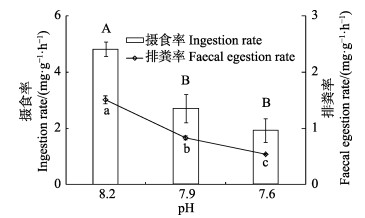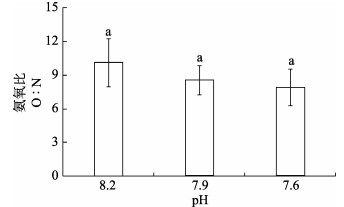2. 青岛海洋科学与技术试点国家实验室海洋生态与环境科学功能实验室 青岛 266071
2. Laboratory for Marine Ecology and Environmental Science, Pilot National Laboratory for Marine Science and Technology (Qingdao), Qingdao 266071
海洋酸化会引发海洋生态系统内的一系列变化(唐启升等, 2013),已对贝类的受精、钙化、生长和繁殖产生负面作用(Parker et al, 2009; Talmage et al, 2011)。双壳贝类是最容易因pH的降低而受到影响的海洋动物之一,海洋酸化将对它们产生严重危胁(Kurihara et al, 2009),可能导致代谢能力、能量存储及生长速度降低(Zhang et al, 2012; Beniash et al, 2010)。目前,海洋酸化对一些经济贝类的生理作用过程尚不清楚。研究海洋酸化对经济贝类生理过程的影响对我国的水产养殖具有重要意义。
魁蚶(Scapharca broughtonii)是一种大型海洋底栖贝类,在我国辽东半岛、山东半岛等沿海资源量丰富,是我国具有重要经济价值的浅海增养殖贝类。由于生境破坏、过度捕捞、疾病暴发和近亲繁殖等因素,导致其种群数量急剧减少(Mao et al, 2013)。近年来,国内许多学者开展了魁蚶的人工增养殖和资源修复等方面的研究(阮飞腾等, 2014; 李阳等, 2018; 薛素燕等, 2019),但有关酸化对其摄食生理及能量收支的影响等尚未见报道。本研究测定了不同pH条件下,魁蚶的摄食率[Ingestion rate, IR, mg/(g·h)]、排粪率[Faecal egestion rate, FER, mg/(g·h)]、耗氧率(Oxygen consumption rate, OR, %)、排氨率(Ammonia excretion rate, NR, %)及能量收支参数,探讨了低pH对魁蚶的摄食、代谢及能量收支的影响,旨在为在日益酸化的海水环境中进行贝类养殖提供参考。
1 材料与方法 1.1 材料实验所用2龄魁蚶取自本课题组在山东青岛市崂山湾增养殖实验的贝类群体,清洁贝壳表面污物和附着生物,选择壳长为(4.31±0.23) cm的个体若干,置于整理箱中暂养。暂养水温为(16.8±1.3)℃,每天全量换水1次,连续充气,并投喂螺旋藻(Spirulina spp.)液2次。实验所用海水经砂滤沉淀后储存备用,海水pH为8.21±0.06,盐度为33.12±0.36,暂养14 d。实验用魁蚶生物学数据见表 1。
|
|
表 1 魁蚶生物学数据(平均值±标准差) Tab.1 Biological characteristics of S. broughtonii (Mean±SD, n = 36) |
设置3个pH梯度分别为8.2、7.9和7.6,其中,pH为8.2实验组是自然海水组,pH为7.9和7.6实验组通过向自然海水连续充入CO2加富空气以降低pH获得,充气时,使用多参数水质监测仪(SmarTROLL-MP, 美国)实时监测海水pH的变化,当pH达到所需值时,减缓纯CO2气体的通入流量,维持pH稳定在实验所需值。本实验中,每个pH实验组设置4个平行,每个平行30只魁蚶,置于方形水槽中(50 cm×30 cm×20 cm),为摄食、呼吸、排泄实验备用。
1.3 摄食实验摄食实验在方形缸(20 cm×15 cm×10 cm)中进行。每个方形缸中放5只魁蚶,2 L海水,水中溶解氧(DO)保持在5 mg/L以上,待魁蚶适应10 min后,投入初始浓度为5 mg/L的螺旋藻液,并保证螺旋藻在水中悬浮均匀。摄食实验的水环境与上述各pH实验组的水环境相同。每个pH摄食组设置4个平行,2个空白对照组(不加魁蚶),实验时间为2 h。实验结束后,将魁蚶取出,用游标卡尺测量魁蚶的规格(壳长、壳高),并称量其鲜重,之后用解剖刀将软组织与壳分开,分别以铝箔纸包封,60℃烘干48 h至恒重,分析天平称重。测定实验前后水体中螺旋藻的饵料浓度,收集实验后魁蚶的粪便,计算魁蚶的IR和FER,公式如下:
| $ {\rm{IR}} = V({C_0}-{C_t})/(N \times t \times W) $ |
式中,V为实验海水体积(ml),C0、Ct分别为实验开始和结束时的饵料浓度(mg/L),N为实验魁蚶数量,t为实验时间(h),W为软组织干重(g)。
| $ {\rm{FER}} = {\rm{IR}} \times \left({1 - {\rm{AE}}} \right) $ |
式中,IR为摄食率,AE为同化率。
同化率(Assimilation rate, AE, %)公式:
| $ {\rm{AE}} = (F - E)/[(1 - E) \times F] \times 100 $ |
式中,F = (POM/TPM),为饵料中有机质的干重比例,E = (POM/TPM),为粪便中有机质的干重比例,POM为颗粒有机物含量,TPM为总颗粒物含量。
1.4 呼吸排泄实验实验前停食24 h,将3只生存状态良好、规格一致的魁蚶(表 1)放入3 L呼吸瓶中,实验持续2 h。每组实验呼吸瓶的水环境与各处理水槽中水环境相同,以不加魁蚶的呼吸瓶为对照,实验设4个平行,2个对照组。放入魁蚶待其适应10 min后作为实验起始时间,根据始末DO和氨氮(NH4+-N)浓度的变化计算OR和NR。在实验结束后,用游标卡尺测量魁蚶的规格(壳长、壳高),并称其鲜重,之后用解剖刀将软组织与壳分开,在60℃烘箱中烘干48 h后,称壳干重和软组织干重。按以下方法计算OR和NR,公式如下:
| $ {\rm{OR}} = ({D_0} - {D_t}) \times V/(W \times t) $ |
式中,OR为单位体重耗氧率[mg/(g·h)],D0和Dt为实验空白对照组和实验组水中DO的含量(mg/L),V为呼吸瓶容积(L),W为软组织干重(g),t为实验持续时间(h),16为氧原子的摩尔质量(g/mol)。
| $ {\rm{NR}} = [({N_t} - {N_0}) \times V]/(1000 \times W \times t) $ |
式中,NR为单位体重排氨率[mg/(g·h)],N0和Nt为实验空白对照组和实验组水中NH4+-N的浓度(mg/L)。V为呼吸瓶容积(L),W为软组织干重(g),t为实验持续时间(h)。
氧氮比公式:
| $ {\rm{O}}:{\rm{N}} = \left({{\rm{OR}}/16} \right)/({\rm{NR}}/14) $ |
式中,O : N为魁蚶OR和NR之间的比值;OR为单位体重OR[mg/(g·h)];NR为单位体重NR[mg/(g·h)]。
采用SmarTROLL-MP(美国)测定实验海水中的DO,采用次溴酸钠氧化法测定水中的氨态氮。
1.5 能量计算贝类能量收支方程:
| $ C = G + R + U + F $ |
式中,C为摄食能,G为生长能,R为呼吸能,U为排泄能,F为排粪能。
生长余力(SFG)为动物摄取的食物能量与其消耗及损失的能量之差,用来预测供生长和再生产的剩余能量。生长余力公式:
| $ {\rm{SFG}} = A - (R + U) $ |
式中,A为吸收能(A = C–F)。
本研究在进行能量预算时,使用如下能量转换因子:1 mg POM = 20.78 J;1 mg O2 = 14.24 J;1 mg NH4+-N = 24.87 J。
1.6 数据分析使用Excel 2016和SPSS 18.0软件进行数据分析和作图,采用单因子方差分析(One-way ANOVA)比较不同数据之间的差异性,P < 0.05为不同处理组间差异显著标准。
2 结果与分析 2.1 短期酸化对魁蚶摄食率和排粪率的影响在本研究中,pH对魁蚶的IR有显著影响(P < 0.05)。魁蚶的IR随pH的降低而减少(图 1),pH为8.2组的IR最高[4.82 mg/(g·h)],显著高于pH为7.9、7.6组(P < 0.05);pH为7.6组的IR和pH为7.9组相比差异不显著(P > 0.05)。

|
图 1 pH胁迫对魁蚶摄食率和排粪率的影响 Fig.1 Effects of pH on the ingestion rate and faecal egestion rate of S. broughtonii 不同字母表示组间差异显著(P < 0.05),下同 Different letters indicate significant difference between treatments (P < 0.05), the same as below |
pH对魁蚶的FER有显著影响(P < 0.05)。魁蚶FER随pH的降低而减少(图 1),pH为8.2组的FER最高[1.51mg/(g·h)],显著高于pH为7.9、7.6组(P < 0.05)。
2.2 短期酸化对魁蚶耗氧率和排氨率的影响本研究中,pH对魁蚶的OR有显著影响(P < 0.05)。魁蚶的OR随pH的降低呈下降趋势(图 2)。pH为8.2组的OR最高[1.04 mg/(g·h)],显著高于pH为7.9、7.6组(P < 0.05)。pH为7.6组的OR最低[0.50 mg/(g·h)]是pH为8.2组的48%(P < 0.05),但与pH为7.9组相比差异不显著(P > 0.05)。

|
图 2 pH胁迫对魁蚶耗氧率和排氨率的影响 Fig.2 Effects of pH on the oxygen consumption rate and the ammonia excretion rate of S. broughtonii |
pH对魁蚶NR的影响不显著(P > 0.05)。随着pH的降低,魁蚶的NR呈先下降再上升的趋势(图 2)。pH为8.2组的NR最高[0.10 mg/(g·h)],pH为7.9组的NR最低[0.06 mg/(g·h)],是pH为8.2组的60%。
2.3 短期酸化下魁蚶的氧氮比的变化本研究中,魁蚶的O : N值随pH的降低呈下降的趋势。pH为8.2组中,O : N值最大(10.12),pH为7.6组O : N值最小(7.91)(图 3)。方差分析表明,pH对魁蚶O : N的影响无显著差异(P > 0.05)。

|
图 3 pH胁迫对魁蚶O : N的影响 Fig.3 Effects of pH on O : N of S. broughtonii |
本研究中,随着pH的降低,魁蚶的摄食能、呼吸能、排粪能和SFG逐渐减少,而排泄能则呈先减少再略有增加的趋势(表 2)。方差分析表明,pH对魁蚶的摄食能、呼吸能、排粪能和SFG均具有显著的影响(P < 0.05)。不同pH条件下,魁蚶的SFG能量收支方程见表 3。
|
|
表 2 魁蚶在不同pH下的能量收支 Tab.2 Energy budget of S. broughtonii at different pH [J/(g·h), Mean±SD] |
|
|
表 3 不同pH下魁蚶的能量收支方程 Tab.3 Energy budget equation of S. broughtonii at different pH |
pH是影响贝类生理代谢的重要环境因子之一。大量研究表明,适宜pH条件下,贝类机体处于标准代谢状态,超出贝类适宜pH范围,其IR明显下降并表现出一定的不适应性(杨杰青等, 2016)。海洋酸化对海洋贝类等矿化生物的影响是备受关注的焦点之一(黄荣莲等, 2017),低pH对海洋贝类的摄食能力具有显著影响(Fernández-Reiriz et al, 2011)。长牡蛎(Crassostrea gigas)、黑唇鲍(Haliotis rubra)处于酸化环境时,其机体处于一种近乎麻痹的状态,且摄食活力明显下降(Bamber et al, 1990; Harris et al, 1999)。在酸化条件下,槽蛤仔(Ruditapes decussatus)幼体的IR显著降低(Fernández-Reiriz et al, 2011)。何苗等(2017)研究也发现,pH的降低对缢蛏(Sinonovacula constricta)的IR存在显著性影响,缢蛏的IR随pH降低呈明显下降趋势。提升CO2浓度对智利贻贝(Mytilus chilensis)稚贝的生理具有非常消极的影响,能够降低其摄食、能量吸收、新陈代谢和最终用于生长的能量(Navarro et al, 2013),与本研究结果相似。本研究中,pH为8.2组魁蚶的IR显著高于pH为7.9、7.6组,同时,魁蚶的FER也随着pH的降低而降低,说明酸化对魁蚶的摄食和排粪产生了一定的消极作用,使得魁蚶对短期的酸化环境表现出不适应性,机体偏离正常的生理状态,导致IR和FER明显下降。
3.2 短期酸化对魁蚶呼吸代谢的影响双壳贝类在海水酸化的胁迫下,无法完全补偿体内酸碱平衡而受到的干扰,使能量代谢受到抑制(Miles et al, 2007)。在多种情况下,代谢抑制是双壳贝类在压力条件下生存的一种适应性策略(Michaelidis et al, 2005; Liu et al, 2012)。Lanning等(2010)研究表明,海洋酸化会抑制长牡蛎的新陈代谢。在长期酸化条件下,地中海贻贝(M. galloprovincialis)会出现呼吸代谢下降的现象(Ding et al, 2012)。在海水低pH环境中,合浦珠母贝(Pinctada fucata)、华贵栉孔扇贝(Chlamys nobilis)和翡翠贻贝(Perna viridis)的新陈代谢均有所下降(Liu et al, 2012)。在严重酸化条件下,贝类新陈代谢降低的主要原因是细胞能量需求的增加和氮损失的协同作用(Thomsen et al, 2010)。但也有研究表明,在酸化胁迫下,槽蛤仔幼体的呼吸率显著降低,而NR增加(Fernández-Reiriz et al, 2011),与本研究结果相似。本研究中,随着pH的降低,魁蚶的OR显著降低,NR呈先降低后略有升高的趋势,但均低于正常海水组,推测魁蚶的呼吸代谢在酸化条件下受到了一定抑制。
O : N值能够反映环境对有机体的压力程度,其值的高低可以作为生物体适应环境压力的指标之一(Widdows et al, 1971)。本研究中,各pH组魁蚶的O : N值虽无显著差异,但低pH组的O : N值均低于正常海水组。当贝类遭受来自外界的胁迫时,其O : N值降低,这与贝类遭受外界胁迫从而降解体内蛋白质形成氨基酸的生理适应相吻合(李晓艳, 2014; 焦海峰等, 2017)。
3.3 短期酸化对魁蚶能量收支的影响海水中CO2浓度上升时,CO2能穿过生物体的细胞膜等结构进入海洋生物体内,使得细胞内的pH降低,打破了细胞内原有的酸碱平衡,生物体会启动一系列调控机制来调节酸碱平衡,而调节过程需要消耗能量(Parker et al, 2013; Gutowska et al, 2010)。如果生物体自身所能产生的能量水平是一定的,那么根据能量守恒定律,离子运输或酸碱维持能量消耗的增加必然会引起其他生命活动能量分配的减少(王秀丹, 2017; Esbaugh et al, 2012; Bechmann et al, 2011)。当美洲牡蛎(C. virginica)处于较高CO2浓度的环境时(pH为7.5),为维持自身的内稳态,其能量消耗大大增加,标准代谢率大大增加(Beniash et al, 2010),与上述研究结果相一致。本研究结果表明,魁蚶的摄食能、呼吸能、排粪能和SFG均随pH的降低而减少(其中,pH为7.6组魁蚶的摄食能仅为pH为8.2组摄食能的40%),排泄能呈先减少后增加的趋势。同时,在pH从8.2降至7.6的过程中,魁蚶呼吸能的占比由14.03%升至17.83%,排泄能占比由2.52%升至4.29%,而排粪能占比由31.31%降至28.05%,生长能占比则由52.14%降至49.82%。在贝类能量分配中,环境变化会引起各部分能量占比发生改变(王有基等, 2014)。随着pH的降低,魁蚶会作出适当的生理调整(如降低摄食率、增加代谢率)以调节因酸化环境造成的体内酸碱平衡紊乱。研究表明,摄入减少和排泄增加通常与能量输入减少有关,海水酸化引起能量输入减少,导致贝类生长缓慢(Fernández-Reiriz et al, 2011)。
Bamber RN. The effects of acidic seawater on three species of lamellibranch mollusc. Journal of Experimental Marine Biology and Ecology, 1990, 143(3): 181-191 DOI:10.1016/0022-0981(90)90069-O |
Bechmann RK, Taban IC, Westerlund S, et al. Effects of ocean acidification on early life stages of shrimp (Pandalus borealis) and mussel (Mytilus edulis). Journal of Toxicology and Environmental Health Part A, 2011, 74(7-9): 424-438 DOI:10.1080/15287394.2011.550460 |
Beniash E, Ivanina A, Lieb NS, et al. Elevated level of carbon dioxide affects metabolism and shell formation in oysters Crassostrea virginica. Marine Ecology Progress Series, 2010, 419: 95-108 DOI:10.3354/meps08841 |
Ding ZK, Li HH, Xu YQ. Effect of ocean acidification on respiratory metabolism of marine living things. Feed Industry, 2012, 33(20): 15-17 |
Esbaugh AJ, Heuer R, Grosell M. Impacts of ocean acidification on respiratory gas exchange and acid-base balance in a marine teleost, Opsanus beta. Journal of Comparative Physiology B: Biochemical Systemic and Environmental Physiology, 2012, 182(7): 921-34 DOI:10.1007/s00360-012-0668-5 |
Fernández-Reiriz MJ, Range P, Álvarez-Salgado XA, et al. Physiological energetics of juvenile clams Ruditapes decussatus in a high CO2 coastal ocean. Marine Ecology Progress Series, 2011, 433: 97-105 DOI:10.3354/meps09062 |
Gutowska MA, Melzner F, Langenbuch M, et al. Acid-base regulatory ability of the cephalopod (Sepia officinalis) in response to environmental hypercapnia. Journal of Comparative Physiology B: Biochemical Systemic and Environmental Physiology, 2010, 180(3): 323-335 DOI:10.1007/s00360-009-0412-y |
Harris JO, Maguire GB, Edwards SJ, et al. Effect of pH on growth rate, oxygen consumption rate, and histopathology of gill and kidney tissue for juvenile greenlip abalone, Haliotis laevigata donovan and blacklip abalone, Haliotis rubra leach. Aquaculture, 1999, 160(3-4): 259-272 |
He M, Lai QF, Yao ZL, et al. Effects of pH and temperature on carbon budget of Sinonovacula constricta. Chinese Journal of Ecology, 2017, 36(4): 1014-1019 [何苗, 来琦芳, 么宗利, 等. pH、温度对缢蛏碳收支的影响. 生态学杂志, 2017, 36(4): 1014-1019] |
Huang RL, Zheng Z, Zhang GF. Gene co-expression network analysis of Pinctada fucata martensii under the stress of ocean acidification and heat. Genomics and Applied Biology, 2017, 36(2): 536-549 [黄荣莲, 郑哲, 张国范. 合浦珠母贝海洋酸化和温度胁迫下基因共表达网络分析. 基因组学与应用生物学, 2017, 36(2): 536-549] |
Jiao HF, Zheng D, Yan QN, et al. Effects of water temperature and salinity on oxygen consumption rate and ammonia excretion rate of Saccostrea cucullata. Acta Ecologica Sinica, 2017, 37(2): 692-699 [焦海峰, 郑丹, 严巧娜, 等. 温度、盐度及交互作用对僧帽牡蛎(Saccostrea cucullata)呼吸排泄的影响. 生态学报, 2017, 37(2): 692-699] |
Kurihara H, Asai T, Kato S, et al. Effects of elevated pCO2 on early development in the mussel Mytilus galloprovincialis. Aquatic Biology, 2009, 4(3): 225-233 |
Lannig G, Eilers S, Pörtner HO, et al. Impact of ocean acidification on energy metabolism of oyster, Crassostrea gigas changes in metabolic pathways and thermal response. Marine Drugs, 2010, 8(8): 2318-2339 DOI:10.3390/md8082318 |
Li XY. Effects of salinity on metabolism of triploid and diploid oyster Crassostrea gigas. Journal of Dalian University, 2014, 35(3): 88-91 [李晓艳. 盐度对三倍体和二倍体太平洋牡蛎代谢影响的比较. 大连大学学报, 2014, 35(3): 88-91] |
Li Y, Xue SY, Li JQ, et al. Effect of Cu2+ stress on physiology biochemistry and histopathological structure of Scapharca broughtonii. Journal of Fisheries of China, 2018, 42(10): 1531-1540 [李阳, 薛素燕, 李加琦, 等. Cu2+胁迫对魁蚶生理生化和组织结构的影响. 水产学报, 2018, 42(10): 1531-1540] |
Liu W, He M. Effects of ocean acidification on the metabolic rates of three species of bivalve from southern coast of China. Chinese Journal of Oceanology and Limnology, 2012, 30(2): 206-211 DOI:10.1007/s00343-012-1067-1 |
Mao YZ, Zhou CY, Zhu L, et al. Identification and expression analysis on bactericidal permeability-increasing protein (BPI)/lipopolysaccharide-binding protein (LBP) of ark shell, Scapharca broughtonii. Fish and Shellfish Immunology, 2013, 35(3): 642-652 DOI:10.1016/j.fsi.2013.05.025 |
Michaelidis B, Ouzounis C, Paleras A, et al. Effects of long-term moderate hypercapnia on acid base balance and growth rate in marine mussels Mytilus galloprovincialis. Marine Ecology Progress, 2005, 293(1): 109-118 |
Miles H, Widdicombe S, Spicer JI, et al. Effects of anthropogenic seawater acidification on acid-base balance in the sea urchin Psammechinus miliaris. Marine Pollution Bulletin, 2007, 54(1): 89-96 |
Navarro JM, Torres R, Acuña K, et al. Impact of mediumterm exposure to elevated pCO2 levels on the physiological energetics of the mussel Mytilus chilensis. Chemosphere, 2013, 90(3): 1242-1248 DOI:10.1016/j.chemosphere.2012.09.063 |
Parker LM, Ross PL, O'Connor WA. The effect of ocean acidification and temperature on the fertilization and embryonic development of the Sydney rock oyster Saccostrea glomerata (Gould 1850). Global Change Biology, 2009, 15(9): 2123-2136 DOI:10.1111/j.1365-2486.2009.01895.x |
Parker LM, Ross PM, O'Connor WA, et al. Predicting the response of molluscs to the impact of ocean acidification. Biology, 2013, 2(2): 651-92 DOI:10.3390/biology2020651 |
Ruan FT, Gao S, Li L, et al. Gonad development and biochemical composition in the ark shell Scapharca broughtonii from coast of Shandong Peninsula. Journal of Fisheries of China, 2014, 38(1): 47-55 [阮飞腾, 高森, 李莉, 等. 山东沿海魁蚶繁殖周期与生化成分的周年变化. 水产学报, 2014, 38(1): 47-55] |
Talmage SC, Gobler CJ. Effects of elevated temperature and carbon dioxide on the growth and survival of larvae and juveniles of three species of northwest Atlantic bivalves. PloS One, 2011, 6(10): e26941 DOI:10.1371/journal.pone.0026941 |
Tang QS, Chen ZD, Yu KF, et al. The effects of ocean acidification on marine organisms and ecosystem. Chinese Science Bulletin, 2013, 58(14): 1307-1314 [唐启升, 陈镇东, 余克服, 等. 海洋酸化及其与海洋生物及生态系统的关系. 科学通报, 2013, 58(14): 1307-1314] |
Thomsen J, Melzner F. Moderate seawater acidification does not elicit long-term metabolic depression in the blue mussel Mytilus edulis. Marine Biology, 2010, 157(12): 2667-2676 DOI:10.1007/s00227-010-1527-0 |
Wang XD. The response and adaptation mechanism of Pacific oyster Crassostrea gigas to ocean acidification.Doctoral Dissertation of Institute of Oceanology, Chinese Academy of Sciences, 2017 [王秀丹.长牡蛎对海洋酸化的响应与适应机制研究.中国科学院大学(中国科学院海洋研究所)博士研究生学位论文, 2017]
|
Wang YJ, Li LS, Li QZ, et al. Research progress on eco-physiological responses of shellfish under ocean acidification and global warming. Acta Ecologica Sinica, 2014, 34(13): 3499-3508 [王有基, 李丽莎, 李琼珍, 等. 海洋酸化和全球变暖对贝类生理生态的影响研究进展. 生态学报, 2014, 34(13): 3499-3508] |
Widdows J, Bayne BL. Temperature acclimation of Mytilus edulis with reference to its energy budget. Journal of the Marine Biological Association of the United Kingdom, 1971, 51(4): 827-843 DOI:10.1017/S0025315400018002 |
Xue SY, Wang JY, Li JQ, et al. Effects of temperature on energy metabolism andantioxidant enzyme activities of Scapharca broughtonii. Journal of Fisheries of China, 2019, 43(3): 573-583 [薛素燕, 王金叶, 李加琦, 等. 温度对魁蚶能量代谢及抗氧化酶活性的影响. 水产学报, 2019, 43(3): 573-583] |
Yang JQ, Jiang M, Li L, et al. Effects of salinity and pH on the filtration rate and ingestion rate of Meretrix meretrix. Progress in Fishery Sciences, 2016, 37(6): 87-93 [杨杰青, 蒋玫, 李磊, 等. 盐度、pH对文蛤(Meretrix meretrix)滤水率和摄食率的影响. 渔业科学进展, 2016, 37(6): 87-93] |
Zhang J, Zhang ZK, Zhang YF. Ocean acidification and its impacts on marine ecosystem. Marine Geology Frontiers, 2012, 28(2): 1-9 |



